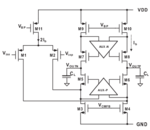Junus2012
Advanced Member level 5
Hello,
I am interesting on enhancing the gain of the fully differential folded cascode amplifier as shown in the figure below,
For the auxilary boost amplifier (AUX-N and AUX-B) I would like to use folded cascode amplifier. As these auxilary amplifiers are also fully differential amplifier they requires a CMFB as well.
For the main amplifier it is very obvoius to use a CMFB amplifier that compare with VCM, which is typically VDD/2 for my application.
My question is :
What is the value of the common mode voltage to compare for the AUX differential amplifier CMFB ?
Thank you

I am interesting on enhancing the gain of the fully differential folded cascode amplifier as shown in the figure below,
For the auxilary boost amplifier (AUX-N and AUX-B) I would like to use folded cascode amplifier. As these auxilary amplifiers are also fully differential amplifier they requires a CMFB as well.
For the main amplifier it is very obvoius to use a CMFB amplifier that compare with VCM, which is typically VDD/2 for my application.
My question is :
What is the value of the common mode voltage to compare for the AUX differential amplifier CMFB ?
Thank you

